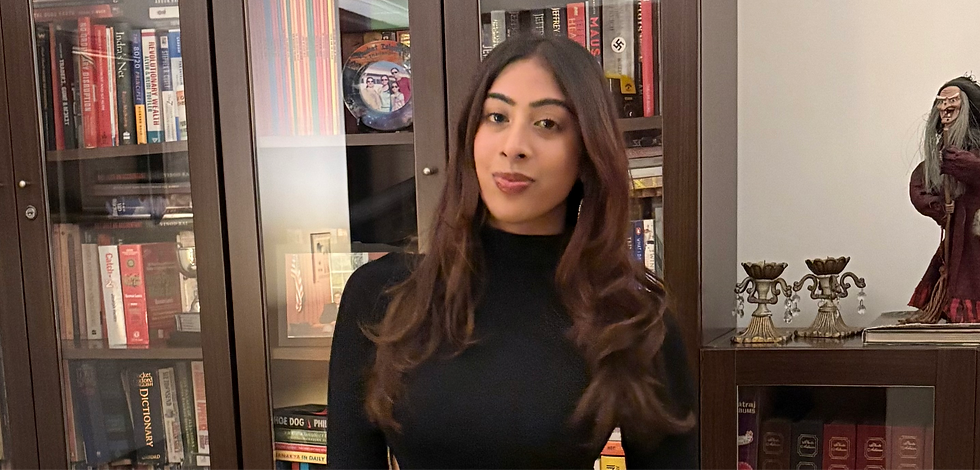More Than Math: How Financial Literacy Empowers Women To Take up Space
- karen2722
- Jul 14
- 4 min read
Updated: Jul 25
By Arushi Menon, Project Intern India

It was almost the end of the school year in Ashoka University and I was wrapping up a financial literacy workshop I was running in Haryana, India when one of the older women we fondly called Didi (meaning “older sister” in Hindi) quietly raised her hand and asked, “Can anyone own a bank account?”
It was such a sincere, almost hesitant question that it stayed with me. She wasn’t confused about money; she understood its value deeply, from lived experience. But no one had ever told her that these systems were meant for her too. That she was entitled to financial independence. That she didn’t have to stand outside them. In that moment, my purpose for the financial literacy workshop took on a new weight. Teaching financial literacy stopped being a task and became a calling. What we were really teaching wasn’t just budgeting or calculators. It was self-belief. Her question showed trust, a sign that she felt safe enough to wonder aloud. It reminded me that financial literacy is about more than information. It is about identity and shifting what people think is possible for themselves.
Why Financial Literacy for Girls and Women Matters
In India, especially in rural and underserved communities, conversations around money often exclude women and girls. Yet, they are central to every financial decision made in a household—from stretching food budgets to managing school fees. During our sessions in the surrounding villages in Haryana state, what struck me most wasn’t a lack of financial intuition. It was a lack of access.
Many of the women we worked with had left school before Grade 10. Formal terms like “savings,” “interest,” or “budgeting” felt abstract at first. But once we connected them to real-life moments—like putting aside money for a daughter’s education or navigating a medical emergency—their eyes lit up. They had been doing the mental math all along, tracking repayments, stretching every rupee. What they needed was someone to tell them: you belong in these systems, too.
One moment I won’t forget was teaching a group how to use a calculator. The next day, a Didi came up to me, beaming. “I helped my daughter with her math homework,” she said. It seemed like a small thing, but it represented something much bigger: confidence, power, and a sense of “I can do this.”
That’s what financial literacy gives. Not just knowledge, but permission. Permission to ask questions, dream and to participate.
Lessons from the Classroom
Teaching these workshops taught me far more than I expected. One of the biggest realizations? We can’t approach financial education with a rigid syllabus. We have to first listen to their stories, to the unspoken roles they played at home, to the decisions they were and weren’t part of.
Some of the women managed daily expenses. Others had little to no say in financial decisions. Understanding those dynamics shaped everything. Without that context, any lesson we offered would’ve floated by, untethered to reality.
Some of the most powerful moments didn’t come from slides or lesson plans, but from open conversations. A woman shared her dream of opening a small restaurant near campus. Another spoke about starting a tailoring business. During the sessions, they began working out costs, asking logistical questions, and sketching their plans out loud for the first time.
For me, financial independence once meant simply supporting oneself. I still believe that, but I now see it also depends on your environment and self-perception. Do people believe in you? Do you feel safe to imagine a different future? Do you believe in yourself? These questions matter.
In India, while we celebrate women breaking glass ceilings, we must also remember those on the ground still navigating deep-rooted patriarchy. In Haryana, we weren’t just teaching budgeting. We were helping women feel seen, reminding them they belong in these conversations and their voices matter.
The Power of RISE and Storytelling
What makes Girl Rising’s RISE curriculum so impactful is that it doesn’t treat gender equity like a checklist of skills. It leads with stories. Stories of girls who navigate obstacles, find their voices, and make decisions in challenging circumstances. Hearing women’s stories and tailoring financial literacy lessons to their unique experiences showed me firsthand how vital it is to lead with storytelling. This is why the Girl Rising curriculum resonates with me so deeply.
When you hear a story from someone who looks like you and shares your struggles, you start believing change is possible. Once you see your story as worth telling, learning deepens and lasting change begins.
What You Can Do
If there’s one key lesson I’ve learned, it’s this: meaningful change starts with listening to stories. Before we teach, we must understand the lived experiences and uni
que challenges of each community. Financial literacy isn’t one-size-fits-all. Every community has its own wisdom, pain points, and potential.
But there are simple but meaningful ways you can support this work:
Volunteer with grassroots organizations.
Translate financial tools into local languages.
Normalize talking about money, especially with the women in your life.
Encourage schools and universities to embed financial literacy into their curricula.
Because ultimately, financial equity isn’t just about income—it’s about inclusion. It’s about making sure women and girls everywhere know: this world includes you, too.




Comments